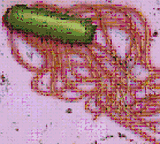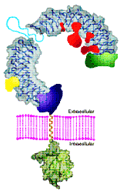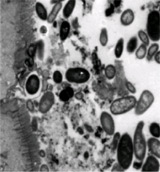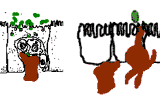How does the gut immune system know its
microbial friends from its microbial foes?
![]()
Here on her site is a Belorussian translation of this page created by Martha Ruszkowski
 |
A
host organism’s survival depends
critically upon getting the right answer: if a pathogenic microbe gets
mistaken
for a commensal, immune responses will start too late—or not at all.
And if
the opposite happens, the immune system will attack an innocuous
microbe
causing inflammatory damage—the situation thought to underlie
inflammatory
bowel disease. |
 |
Charles
Janeway in 1989 proposed that microbial friends and foes
are distinguished by the use of pattern recognition receptors (PRRs)
that
detect molecular patterns associated with pathogens (PAMPs). The
discovery of
Toll-like receptors (TLRs) in 1997 strikingly confirmed this approach.
But are
molecules the only way that pathogens are recognized as distinct from
commensals? |
 |
Oddly, no one has yet discussed that mucosal immunity could also exploit the differences in microbial motility to intestinal epithelial cells (IEC). The gut wall obviously lacks the equivalent of “microscopes” that can directly observe microbial behavior to the IEC, but mucosal immunity can indirectly determine it by how it samples microbes from the lumen. The epithelium seeking motility of pathogens biases their catchment by “honey pot traps”, while commensals will tend to be immobile in the IEC adjacent biofilm. |
 |
Different kinds of microbe sampling can be therefore be biased to catch pathogens compared to commensals and vise versa. This need to have biased sampling I suggest in part explains why the mucosal immunity has evolved two different methods for obtaining microbes from the gut: M-cells (biased for sampling pathogens) and intraepithelial dendritic cell protrusions (biased for sampling commensals). |
Outline of immunity pathogen/commensality classification by differential sampling, 1280 words
M-cells and knowing your microbial friends, talk UCL, Feb 16th, 2005 Powerpoint, 7.7 M 46 slides
Further related ideas